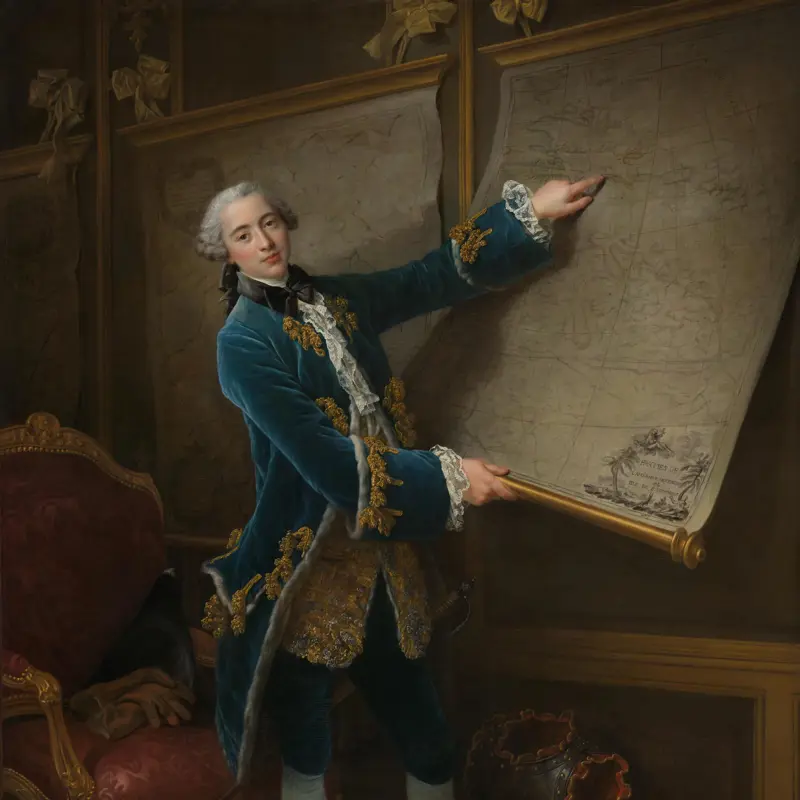‘Joseph Hyacinthe François de Paule de Rigaud, Comte de Vaudreuil (1740–1817) was born at Saint Domingue in the French Antilles. At the age of nineteen, Vaudreuil entered the army, and during the Seven Years War, served as a staff officer under the Prince de Soubise. When peace was declared, he devoted his energies to the pursuit of the epicurean delights he found at court and in fashionable Parisian society. Income from his far-off plantations provided him with the wherewithal to live on the grandest of scales. He acquired impressive collections of art, furniture, and curiosities, arranging them in his Paris house and at his Chateau de Gennevilliers. His mistress was a distant cousin, Yolande de Polastron, Comtesse, later Duchesse de Polignac. As the favourite of Marie Antoinette, she was able to obtain for him very remunerative appointments. In 1780, he was made Marechal de Camp, Governor of the citadel of Lille and Grand Falconer of France (this possibly explains the meaning of the bird on the top of the present frame). At Versailles, Vaudreuil became the guiding spirit of the Polignac faction. When Calonne fell from grace, Vaudreuil’s credit dried up. The Queen turned resolutely against him. On the brink of financial ruin, he was obliged to sell off his collections. In 1787 he traveled to England and Rome but was back in Paris by the end of the following year. During twenty-five years of exile, Vaudreuil vainly worked to organize a counter-Revolution and reestablish the regime he had so unwittingly helped to undermine. In 1795, he married his twenty-year-old cousin, Marie Josephine Hyacinthe Victoire de Vaudreuil (1774–1851). Two sons were born to them, Charles Philippe Louis Joseph Alfred (1796–1880) and Victor Louis Alfred (1798–1834). He returned to Paris after the collapse of the First Empire and Louis XVIII appointed him to the Chambre des Pairs and to the Institut. He died at the age of 77’. (Bonhams (London), The Albion Collection of Fine Portrait Miniatures [online], 22 April 2004, <https://www.bonhams.com/auctions/11185/lot/79/?page_anchor=r1%3D164%26m1%3D1> accessed 6 August 2021, lot 79.)
Joseph-Hyacinthe-François de Paule de Rigaud, comte de Vaudreuil
This person is the subject of ongoing research. We have started by researching their relationship to the enslavement of people.
Biographical notes
Slavery connections
‘He was the son of the governor and commander-general of Saint-Domingue, at that time a French colony on the western end of the Caribbean island of Hispaniola. ... Vaudreuil was in France by 1757, having left Saint-Domingue (his father ceased to be governor the same year). ... The count continued his military career while also amassing great wealth through inheritance and from his sugarcane plantations at Saint-Domingue. ... In 1791 a slave rebellion broke out on Saint-Domingue. The new French Republic abolished slavery in its colonies in 1794, although it was temporarily restored by Napoleon in 1802. The French finally withdrew in late 1803 and the following year western Hispaniola declared independence as Haiti, its indigenous name’. (‘The Comte de Vaudreuil’, <https://www.nationalgallery.org.uk/paintings/francois-hubert-drouais-the-comte-de-vaudreuil> accessed 6 August 2021.)
‘Income from his far-off plantations provided him with the wherewithal to live on the grandest of scales. He acquired impressive collections of art, furniture, and curiosities, arranging them in his Paris house and at his Chateau de Gennevilliers’. (Bonhams (London), The Albion Collection of Fine Portrait Miniatures [online], 22 April 2004, <https://www.bonhams.com/auctions/11185/lot/79/?page_anchor=r1%3D164%26m1%3D1> accessed 6 August 2021, lot 79.)
Abolition connections
No known connections with abolition.
National Gallery painting connections
Sitter: The Comte de Vaudreuil is the subject of François-Hubert Drouais’s portrait of 1758 (NG4253), which was presented to the NG by Barons Emile-Beaumont d‘Erlanger, Frédéric d’Erlanger and Rodolphe d'Erlanger, in memory of their parents, in 1927.
Bibliography
anon., 'Vaudreuil, Comte de [Paule de Rigaud, Joseph-Hyacinthe-François de]', in J. Turner et al. (eds), Grove Art Online, Oxford 1998-, https://doi.org/10.1093/gao/9781884446054.article.T088297
Checked and found
—
Item on publisher's website
History of Parliament Trust (ed.), The History of Parliament: British Political, Social & Local History, London 1964-, https://www.historyofparliamentonline.org/
Checked and not found
—
Item on publisher's website
C. Matthew et al. (eds), Oxford Dictionary of National Biography, Oxford 1992-, https://www.oxforddnb.com/
Checked and not found
—
Item on publisher's website
UCL Department of History (ed.), Legacies of British Slave-ownership, London 2020, https://www.ucl.ac.uk/lbs/
Checked and not found
—
Item on publisher's website
Wine, Humphrey, National Gallery Catalogues: The Eighteenth Century French Paintings, London 2018
Checked and found
—
Publisher's cover shot

